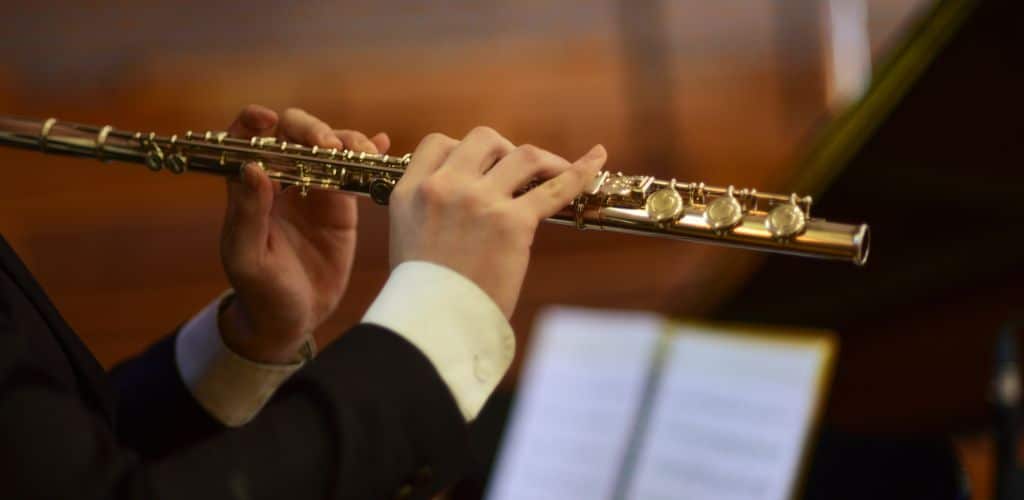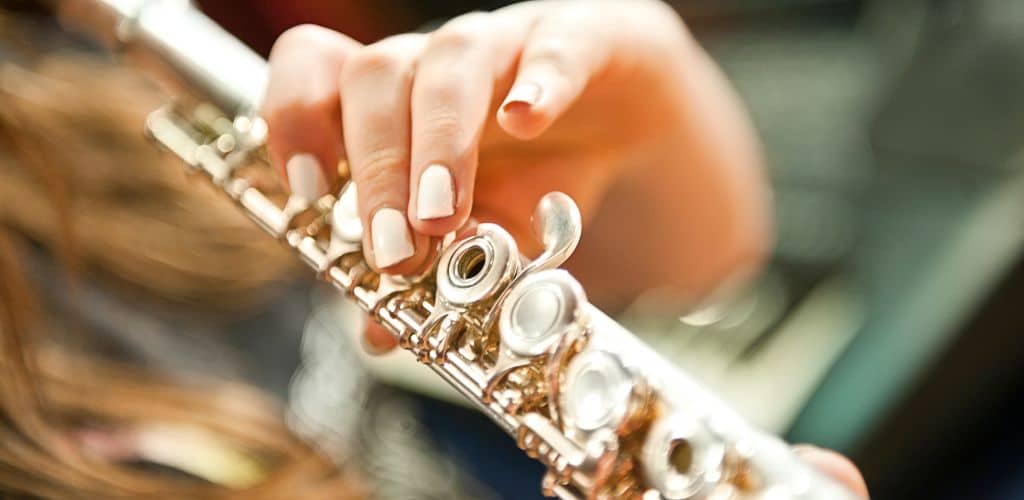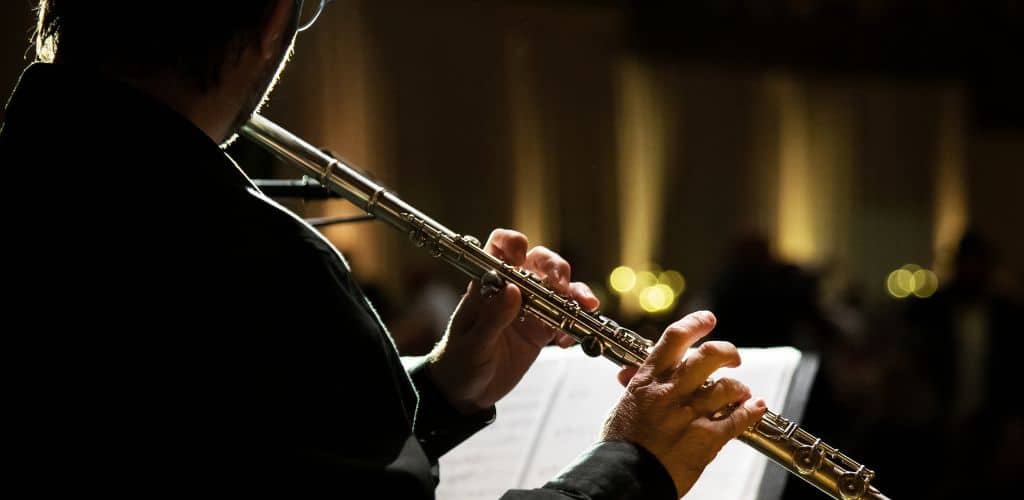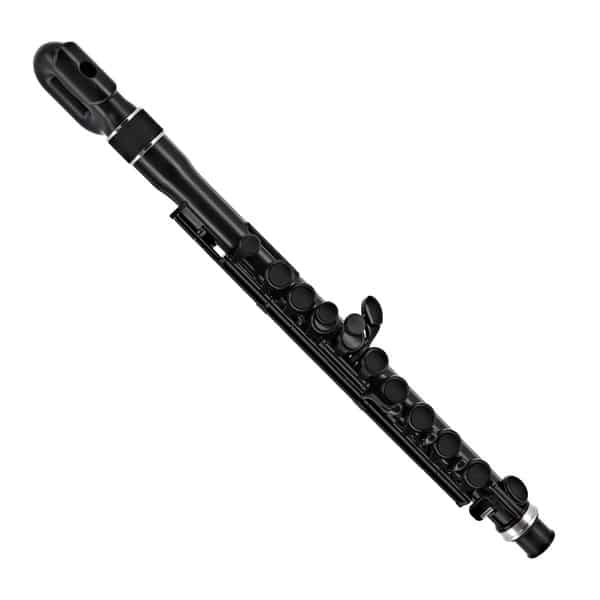Best
Budget-Friendly Beginner Flute
-
Overall: Innovative "Donut" head joint for effortless key access by smaller hands
-
Best Feature: Features grip spots for optimal hand positioning
-
TedScore™: 7/10
Best
Student Flute Overall
-
Overall: Versatile sound with excellent tuning
-
Best Feature: Robust nickel silver body for clear, rich tones
-
TedScore™: 9/10
Best
Durable Student
Flute
-
Overall: The nickel-silver body is both sturdy and lightweight
-
Best Feature: The free-blowing head joint facilitates easier note production
-
TedScore™: 8/10

Consider your flute warm-ups as the initial splash in a pond, creating the foundation for the music you’re going to produce.
Whether you’re a budding enthusiast or a seasoned performer, mastering the art of warming up is crucial for coaxing the sweetest melodies from your silver conduit.
Before you dive into conquering sonatas, a world of harmonious prep work awaits. From gentle long tones that give your breath life to sprightly technical exercises that dance under your fingers, you’re about to embark on a journey that fine-tunes your instrument and prowess.
Don’t forget, every maestro begins with a single note; let this be yours. Are you ready to make your practice sessions sing?
Let’s explore how warming up can transform your flute play into a resonant art form.
Fundamentals of
Flute Warm-Ups

Priming your skills with fundamental flute warm-ups is essential before the magic happens…
Embouchure Development
Your embouchure is your sound’s sculptor. Start with slow scales across 1-2 octaves, focusing on seamless transitions between notes. Here’s a simple exercise you can incorporate:
Sustained notes and Lip Slurs: Begin with a comfortable middle register note, holding it steady and focusing on producing a clear tone. Gradually, work through different pitches to challenge the stability and agility of your embouchure.

Remember, patience is key—rushing might reinforce poor habits.
Breathing Techniques
Breathing fuels your flute playing, both the power and subtlety of it. Here’s how you can make sure you’ve got the breath support you need:
Deep breathing exercises: In a relaxed posture, inhale deeply through your nose, fill your diaphragm, and then exhale through your mouth. Aim to make your exhalation steady and controlled to practice support.
Phrasing exercises: Pick a phrase from your repertoire and play it while focusing on using your air efficiently to achieve smooth and connected notes. This trains your muscles to provide consistent support throughout more complex pieces.
Combine these techniques to bring clarity, precision, and life to your music!

Technical Exercises for
Flute Mastery

Scales and arpeggios, along with articulation drills, form the core of acquiring impeccable technique.
Scales are the building blocks of music, and practicing them does wonders for your technical skills. When you practice scales:

Use a metronome to keep a steady tempo.
Begin with major scales, playing them legato (smoothly slurred) across the full range of your flute.
As your confidence grows, progress to minor scales and increase the range from 1 to 2 octaves.

For Arpeggios, remember they are the spine of chords:
Practicing arpeggios improves your finger strength and intonation.
Execute these exercises both slurred and with separated articulations for variety.
Articulation Drills
Incorporating articulation drills in your daily exercises can transform a piece from mundane to mesmerizing:

Start with single tonguing exercises using a syllable like “ta” or “da” to get a clean attack.
As you get comfortable, experiment with double tonguing (“taka” or “daga”) to sharpen your articulation.
Use a metronome to challenge and refine your rhythm and speed.
Mix rhythms and patterns to keep your practice sessions engaging.
Tone and Intonation Enhancement

Mastering the subtleties of tone and intonation on the flute calls for focused warm-up routines. Coax your flute to sing with clarity and pitch-perfect precision.
Long Tones and Dynamics
Begin in the middle range where comfort is your ally, and gradually ascend to those soaring high notes and descend to the profound depths of the low notes.
High Notes: Keep them pure and prevent sharpness, using less air speed and more support.
Low Notes: To achieve a rich, full sound, focus on increased air flow with controlled support.

Play each long tone with intention, varying the dynamics from pianissimo to fortissimo:
Start softly (p), bloom into a full, resonant sound (f), and then gracefully return to a whisper (p).
Remember, this isn’t just about volume; it’s about control and ensuring your tone quality never falters.
Tuner and Metronome Use
Your trusty tuner is more than a gadget; it’s your roadmap to intonation excellence. As you play those long tones, keep an eye on the tuner:
For consistent pitch, aim to keep the needle steady.
Use the tuner to understand how your pitch changes with dynamics.
Don’t forget your metronome! Rhythmic precision is the dance partner to great intonation:
Match your long tones with a steady beat to develop a keen sense of timing.
Challenge yourself by holding notes steadily across multiple beats.
Your ear, tuner, and metronome create a powerful trio for honing your sound. Embrace them, and your flute will be warm and impeccably in tune.

Advanced Flute Techniques

Focusing on precision and intricacy, particularly with vibrato exercises and extended techniques, will add depth and expressiveness to your performances.
To develop a controlled and even vibrato, start with simple long tones across your entire range, from the warm low notes to the bright high notes. Use a metronome to practice varying speeds of vibrato:
Slow Vibrato: Begin with a slow pulsation, matching each vibrato wave to the metronome’s tick.
Speed Increase: Gradually speed up the metronome, ensuring your vibrato remains even and consistent.


These exercises help you maintain steady air support and embouchure control across all intervals, which is essential for performing captivating melodies with emotional depth.
Best Flutes for Beginners
Yamaha YFL212 Student Model Flute

DESIGNED FOR: beginner flute players
FEATURES: Versatile sound with excellent tuning
OTHER INFO: Robust nickel silver body for clear, rich tones
Yamaha YFL212 Student Model Flute
- Enjoy comfortable play with offset G and E-mechanism
- Perfect for nurturing student skills
- Includes a 5-year extended warranty and 3-month Tomplay Premium
- Comes with a maintenance kit, hard case, and soft cover
- Quite expensive compared to other beginner flute brands
When you click ‘Check Price’, you’ll see there are loads of great places to buy this item. Our personal favorite is Sweetwater for the US, and Thomann and Gear4Music for the UK & Europe.
They are the largest music retailers, with excellent customer service, competitive prices, really fast shipping, and the longest guarantees.
The professional musician who wrote this article combined many things,
from the product build, manufacturer’s reputation through to feedback
from other users, to create our famous TedScore™.
Nuvo jFlute 2.0 Outfit

FEATURES: Innovative "Donut" head joint for effortless key access by smaller hands
OTHER INFO: Features grip spots for optimal hand positioning
- Crafted from durable ABS resin for longevity
- Designed with waterproof features for hassle-free maintenance
- Appropriate for all ages and skill levels
- Comes with a comprehensive beginner's kit
- Offered in an array of lively colors
- Produces a distinctively rich sound unlike metal flutes
When you click ‘Check Price’, you’ll see there are loads of great places to buy this item. Our personal favorite is Sweetwater for the US, and Thomann and Gear4Music for the UK & Europe.
They are the largest music retailers, with excellent customer service, competitive prices, really fast shipping, and the longest guarantees.
The professional musician who wrote this article combined many things,
from the product build, manufacturer’s reputation through to feedback
from other users, to create our famous TedScore™.
Trevor James TJ5X Student Flute

DESIGNED FOR: beginners and intermediate players
FEATURES: The nickel-silver body is both sturdy and lightweight
OTHER INFO: The free-blowing head joint facilitates easier note production
Trevor James TJ5X Student Flute
- It provides an ergonomic playing experience with an offset G and split E mechanism
- Comes with a purple-lined wooden case and black, fleece-lined cover
- Delivers exceptional value and undergoes meticulous quality control
- May not meet the needs of advanced players seeking higher-quality
When you click ‘Check Price’, you’ll see there are loads of great places to buy this item. Our personal favorite is Sweetwater for the US, and Thomann and Gear4Music for the UK & Europe.
They are the largest music retailers, with excellent customer service, competitive prices, really fast shipping, and the longest guarantees.
The professional musician who wrote this article combined many things,
from the product build, manufacturer’s reputation through to feedback
from other users, to create our famous TedScore™.
Flute Warm Ups:
Final Thoughts

As a young flutist, I vividly remember the transformative power of a solid warm-up routine—like a musical espresso that gave my tone and technique a much-needed boost.
Craft a warm-up that resonates with your unique flute voice; whether you love scales or adore melodies, let them dance through your warm-up.
Your breath is the secret sauce, so inhale deeply, support each note from your core, and watch your music bloom.
Avoid a yawn-worthy routine by adding a dash of creativity; stir in new exercises or a challenging piece you’ve been eyeing to keep your brain and fingers on their toes.
Remember, a warm-up is like a lively handshake with your flute; greet your instrument with energy and enthusiasm, and you’ll part ways on a high note—excited for tomorrow’s ‘hello’!
Keep it light, keep it fun, and keep your flute singing. Happy practicing!
Wait, there’s more…
If you want to learn more about flute playing, check out this next article.
FAQ's
A good warm-up for flute includes practicing long tones, scales, and technical exercises to improve breath control and tone quality. Doing gentle warm-ups for 5-10 minutes can help prepare the flute for playing.
The time it takes to warm up a flute varies, but dedicating 5-10 minutes to long tones and gentle exercises can help prepare the instrument for playing. A start warming routine can effectively prepare the flute for playing.
Long tones for the flute involve playing sustained notes with a steady, controlled breath to improve tone production and breath support. Going over long tones in every practice session helps flutists develop a consistent and beautiful sound.











I appreciate the detailed exploration of flute warm-ups and technical exercises. However, it’s important to note that while tuner and metronome use is advocated for tone and intonation enhancement, developing a good ear is equally crucial. Relying solely on devices might impede the development of an intuitive sense for pitch and rhythm, which are integral aspects of musicianship. Encouraging students to sometimes practice without these aids can foster a more innate musicality.
So, if I master these, can I become the next Ron Burgundy? Asking for a friend. 😉
This is a well-structured article that touches on important aspects of mastering the flute, such as embouchure development and the use of tuners and metronomes, which are crucial for intonation enhancement. I found the section on advanced techniques particularly insightful. It’s refreshing to see content that dives deep into both fundamentals and advanced concepts, providing a comprehensive learning path for players across all levels.
Can you explain more about embouchure development? Struggle with it a bit.
Hey there, Chloë! Quick question on the breathing techniques part – do you reckon it’s more about lung capacity or controlling the outflow? I’ve been playing for a bit but still get dizzy sometimes. Thanks for the insights!